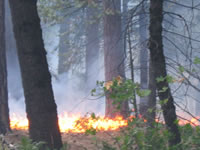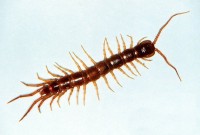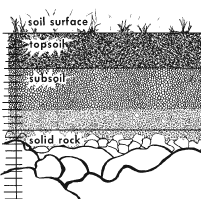The soil macronutrients are the elements considered essential for plant growth and nutrition needed in relatively large quantities. They are most likely to impact site productivity and vegetation dynamics.
| Nutrient category | Element | Chemical Symbol | Function in plant |
|---|---|---|---|
| Primary macronutrients | Nitrogen | N | Proteins, amino acids | Phosphorus | P | Nucleic acids, ATP | Potassium | K | Catalyst, ion transport | Secondary macronutrients | Calcium | Ca | Cell wall component | Magnesium | Mg | Part of chlorophyll | Sulfur | S | Amino acids |
 Some nutrient dynamics are more sensitive to fires than others. The concentration of potassium, calcium, and magnesium ions in the soil can increase or be unaffected by fires whereas nitrogen and sulphur often decrease (Hough 1981). Although the relationship between fire and soil nutrients is complex because of the interactions among many factors, fire intensity is usually the most critical factor affecting post-fire nutrient dynamics, with greater nutrient losses occurring with higher fire intensity. Fire intensity both directly and indirectly impacts many of the mechanisms that affect nutrient pools and cycling. Fire temperature directly determines the amounts and kinds of nutrients that will be volatilized. For instance, N begins volatilizing out of organic matter at only 200º C, whereas Ca must be heated to 1240º C for vaporization to occur (Neary et al. 1999). Nutrients are abundant in superficial organic soil layers, and the amount of these layers consumed is proportional to fire intensity. As an indirect effect, the physical transport of nutrients off site is related to fire intensity. Convective transport of ash varies from 1% in low intensity fires to 11% in high intensity fires (Neary et al. 1999). High intensity fires can also change the physical characteristics of the soil making it more susceptible to nutrient loss through erosion (McColl an Grigal 1977).
Some nutrient dynamics are more sensitive to fires than others. The concentration of potassium, calcium, and magnesium ions in the soil can increase or be unaffected by fires whereas nitrogen and sulphur often decrease (Hough 1981). Although the relationship between fire and soil nutrients is complex because of the interactions among many factors, fire intensity is usually the most critical factor affecting post-fire nutrient dynamics, with greater nutrient losses occurring with higher fire intensity. Fire intensity both directly and indirectly impacts many of the mechanisms that affect nutrient pools and cycling. Fire temperature directly determines the amounts and kinds of nutrients that will be volatilized. For instance, N begins volatilizing out of organic matter at only 200º C, whereas Ca must be heated to 1240º C for vaporization to occur (Neary et al. 1999). Nutrients are abundant in superficial organic soil layers, and the amount of these layers consumed is proportional to fire intensity. As an indirect effect, the physical transport of nutrients off site is related to fire intensity. Convective transport of ash varies from 1% in low intensity fires to 11% in high intensity fires (Neary et al. 1999). High intensity fires can also change the physical characteristics of the soil making it more susceptible to nutrient loss through erosion (McColl an Grigal 1977).The impact of fire on site productivity is also related to intensity. While high intensity fires tend to decrease site productivity, low intensity fires can increase site productivity (Carter and Foster 2003). In one study of low intensity prescribed fire, nearly all the fire effects were limited to the forest floor and that the effects were weak. When compared to an unburned stand, nutrient pools in frequently burned stands were unaffected (P, Mg, K, S), increased slightly (Ca), or decreased (N, S). Though the N pool decreased in the top soil layer, they observed that site productivity was unaffected, possibly from increased mineralization rates in lower soil horizons. In an analysis of fire effects on N, it was found that the N pool in fuels decreased, soil N pools were unaffected and ammonium and nitrate levels in the soil increased which increased N availability. Reports on the effects of fire on soil N pools have been controversial, both because of the importance of N as it affects site productivity and because of its complicated response.
Although the fire-soil nutrient relationship is complicated, some generalities do emerge. Fires typically result in the reduction of fuel and organic soil nutrient pool sizes, increase soil nutrient turnover rates, and redistribute nutrients through the soil profile (Fisher and Binkley 2000). Fire intensity will most likely determine post-fire soil nutrient dynamics. High intensity fires usually decrease nutrient pools more than low intensity fires and can have many other post-fire impacts that lower site productivity. Nutrient pools in the organic soil horizons are more likely to be impacted by fires than those in the mineral horizons. N and S in these pools are particularly sensitive to fires, and tend to diminish when organic soil horizons are consumed regardless of fire intensity, but mineral N concentrations tend to increase and become more available in the soil surface after burning (Wan et al. 2001). Pools of P, K, Mn, Mg, and Ca are generally not as likely to be impacted by low intensity fires, but can be lost after high intensity.
Plant Roots and Fire
There is a large amount of information available to detail the effects of fire on plants. The range of effects depends largely on the community of plants present in a forested landscape (fire tolerant species, fire sensitive species, or a mixture), and on the intensity of the fire. Fire almost always results in the death of some plants in a given system, and the extent to which plants are killed has a strong relationship to the effects of fire on roots. The killing of fire sensitive plants aboveground results in an input of dead roots belowground, and this input of new material has the potential to influence the decomposers (microbes) as well as the entire soil food-web at least in the short term.
Soil Microbes and Fire
The effects of fire on soil microbes is dependent to a large extent upon fire intensity. The responses of soil microbes to fires range from no detectable effect in low intensity fires to total sterilization of the surface layers of soil in very hot wildfires (see Joergensen and Hodges 1970; and Renbuss et al. 1973). This early work focused primarily on the abundance of microorganisms and not their activity levels. This is interesting because workers have observed that although there is a decrease in abundance of microbes following fire, the remaining microbes can have levels of activity that are greater than that of the microbial community prior to the fire (Poth et al. 1995). These authors found that the increased rates of microbial processes, such as denitrification and production of methane and carbon dioxide, persisted for one year following fire.
Microinvertebrates and Fire
 There is a general reduction of microarthropods with increasing fire frequency. One study showed that mites and springtails were reduced by a small amount (~25%) by periodic fires, but that the reduction was dramatic (75-80% fewer) when fires occurred annually. Similar studies have shown that reduction of litter mass with prescribed fire generally results in reductions of microarthropod numbers (Dress and Boerner 2004; Brand 2002). The negative effect of fire is mostly attributed to decreased habitat for mites and springtails, because many of these organisms live in decomposing leaf litter, and much of this litter is lost in fires. The consequences of these reductions for the decomposition of new leaf litter have not been thoroughly addressed.
There is a general reduction of microarthropods with increasing fire frequency. One study showed that mites and springtails were reduced by a small amount (~25%) by periodic fires, but that the reduction was dramatic (75-80% fewer) when fires occurred annually. Similar studies have shown that reduction of litter mass with prescribed fire generally results in reductions of microarthropod numbers (Dress and Boerner 2004; Brand 2002). The negative effect of fire is mostly attributed to decreased habitat for mites and springtails, because many of these organisms live in decomposing leaf litter, and much of this litter is lost in fires. The consequences of these reductions for the decomposition of new leaf litter have not been thoroughly addressed.Macroinvertebrates and Fire
The general pattern of macroinvertebrate responses to fire is often driven by changes in habitat structure, or by changes in the amount or the quality of food resources. Whenever fire affects vegetation, temperature or moisture, or the nutrient status of a soil, there is potential for impact on the soil invertebrate community. Some arthropod groups increased in abundance but most decreased soon after fire.
 A study of litter dwelling and soil dwelling macroinvertebrates showed that the density of macroinvertebrates was significantly reduced one year after a prescribed fire (Kalisz and Powell 2000). Reduction in the number of beetle larvae accounted for a large proportion of the difference following fire, and the authors proposed that repeated fire in a single location could potentially have long-term negative effects on beetle populations and on the functions these beetles perform within the system.
A study of litter dwelling and soil dwelling macroinvertebrates showed that the density of macroinvertebrates was significantly reduced one year after a prescribed fire (Kalisz and Powell 2000). Reduction in the number of beetle larvae accounted for a large proportion of the difference following fire, and the authors proposed that repeated fire in a single location could potentially have long-term negative effects on beetle populations and on the functions these beetles perform within the system.Several studies have been conducted in grassland soils in Kansas that focused on the responses of soil macroinvertebrates to fire. Studies have repeatedly shown that earthworms are strongly affected by fire in tallgrass prairie soils, and the usual pattern observed is for fire to increase the abundance of earthworms in undisturbed areas (e.g., James 1982). However, in more disturbed areas (i.e. close to human habitations), fire also has the interesting effect of limiting the colonization of non-native earthworms into prairie soils (Callaham et al. 2003). Results of this study suggested that the native earthworms in grassland soils are adapted to the warmer soil conditions frequently found in burned prairie, and that because fire improves the performance of grasses, the native earthworms may have strong habitat preferences for soils with abundant grass roots.
http://fire.forestencyclopedia.net/Encyclopedia_Page.2004-10-20.2326/Encyclopedia_Page.2004-11-10.5122/Encyclopedia_Page.2005-01-23.5446/document_view
Fire Effects on Soil Organic Matter
Soil organic matter (SOM), or humus, contains significant supplies of nitrogen (N), phosphorus, and sulfur and thus is an important storehouse of plant nutrients. SOM is approximately 50% carbon (C) by mass. SOM also increases soil water-holding capacity, stabilizes soil aggregates, and decreases the toxicity of aluminum to plants (Stevenson 1994).
Biodegradation of Organic Forms of Carbon and Nitrogen as Affected by Fire
Fire appears to increase the amount and biodegradation rate of readily decomposable soil organic matter while simultaneously increasing the resistance of the stable portion of soil organic matter. The increased decomposition activity that immediately follows fire is likely a result of increased levels of readily decomposable C as well as increased pH, the conversion of nutrients to soluble forms, increased soil temperature, and increased water availability to microbes due to lessened plant water demands. The increased decomposition activity in recently burned soils is viewed as an important nutrient conservation mechanism, as it leads to microbial retention of nutrients that might otherwise be lost from the soil (Woodmansee and Wallach, 1981). The fire-related decreases in the decomposition rates of resistant carbon probably stem from the conversion of humus to “black carbon.”
Charcoal (“Black Carbon”) and Its Effect on Soil Properties
Charcoal, when applied to soil in amounts expected after wildfire, enhanced plant nitrogen uptake, altered the competitive balance between plant species (including ericaceous species), and stimulated moss and fern production in a Swedish boreal forest ecosystem. These effects were attributed to charcoal’s ability to bind and deactivate phenolic compounds in the soil (Wardle et al. 1998).
Fire Effects on the Chemical Properties of Soil Organic Matter
Heating soil organic matter in the laboratory produces rapid losses of carbohydrates and proteins and eventually produces residues rich in aromatic compounds. The aromatic compounds formed include aromatic forms of nitrogen, which may be responsible for the reduced N availability observed in some burned areas. N is the major limiting nutrient in most forests. Hydrophobic polymers are also formed upon heating, and these are probably responsible for the soil hydrophobicity that is observed after fire.
Effects of Fire on Soil Physical Properties
Fire may alter several physical soil properties, such as soil structure, texture, porosity, wetability, infiltration rates, and water holding capacity. The extent of fire effects on these soil physical properties depends on fire intensity, fire severity, and fire frequency. Low intensity fires do not cause enough soil heating to produce significant changes to soil physical properties.
Potential effects of fire on soil physical properties
 Intense burns may have detrimental effects on soil physical properties by consuming soil organic matter. Since soil organic matter holds sand, silt, and clay particles into aggregates, a loss of soil organic matter results in a loss of soil structure. By altering soil structure, severe fires can increase soil bulk density, and reduce soil porosity, mostly through the loss of macropores (>0.6 mm diameter). Soil porosity can also be reduced by the loss of soil invertebrates that channel in the soil. When fire exposes mineral soils, the impact of raindrops on bare soil can disperse soil aggregates and clog pores, further reducing soil porosity.
Intense burns may have detrimental effects on soil physical properties by consuming soil organic matter. Since soil organic matter holds sand, silt, and clay particles into aggregates, a loss of soil organic matter results in a loss of soil structure. By altering soil structure, severe fires can increase soil bulk density, and reduce soil porosity, mostly through the loss of macropores (>0.6 mm diameter). Soil porosity can also be reduced by the loss of soil invertebrates that channel in the soil. When fire exposes mineral soils, the impact of raindrops on bare soil can disperse soil aggregates and clog pores, further reducing soil porosity.Intense fires (> 400 C) may also permanently alter soil texture by aggregating clay particles into stable sand-sized particles, making the soil texture more coarse and erodible. In some cases, increasing the coarseness of clays can make soils more permeable to air and water.
Intense burns may induce the formation of a water repellent soil layer by forcing hydrophobic substances in litter downward through the soil profile. These hydrophobic organic compounds coat soil aggregates or minerals creating a discrete layer of water repellent soil parallel to the surface. Water repellent soil layers are reportedly formed at temperatures of 176-288°C and destroyed at >288°C. Extensive water repellent layers can block water infiltration and contribute to runoff and erosion. Formation of water-repellent layers is an important concern in western shrublands.
Decreased soil porosity and the formation of water repellent layers decrease water infiltration rates. Loss of soil organic matter and increased bulk density can decrease the water storage capacity of soils. In flat terrain, this contributes to soil desiccation, particularly in the surface soil layer. In steep terrain it can significantly accelerate runoff, ash transport, erosion, and mass wasting. Just exposing soil surfaces can also cause soil erosion. Without the mitigating effects of vegetation on the impact of raindrops, bare soil surfaces can form a sealed surface layer resulting in much higher rates of surface runoff. Surface erosion by wind or gravity can also increase when ground cover, surface litter, and/or duff protecting the mineral soil are removed. For this reason, re-establishment of ground cover naturally or by seeding is the most effective erosion control following fire.
Fine charcoal particles enhance the water-retentive properties of a soil and can make a sandy soil behave like a clay. While this effect could be ecologically significant in bottomland sites where it could contribute to poor drainage and waterlogged conditions, it has not been investigated or reported in the southern U.S.
By altering soil physical properties and soil hydrology, fire can also have indirect effects on plants. Plant uptake of nutrients and water is slowed in structurally degraded soils through the combined effects of lower soil moisture and lower soil porosity. Root growth can also be impeded by increased bulk density and soil strength.
The long-term effects of fire on soil physical properties range from a single season to many decades, depending on the fire severity, rate of recovery as influenced by natural conditions, post-fire use, and restoration and rehabilitation actions. Persistent soil degradation following fire is more common in the cold and/or arid climates typical of the western U.S.